1996 PONTIAC BONNEVILLE check engine
[x] Cancel search: check enginePage 191 of 387
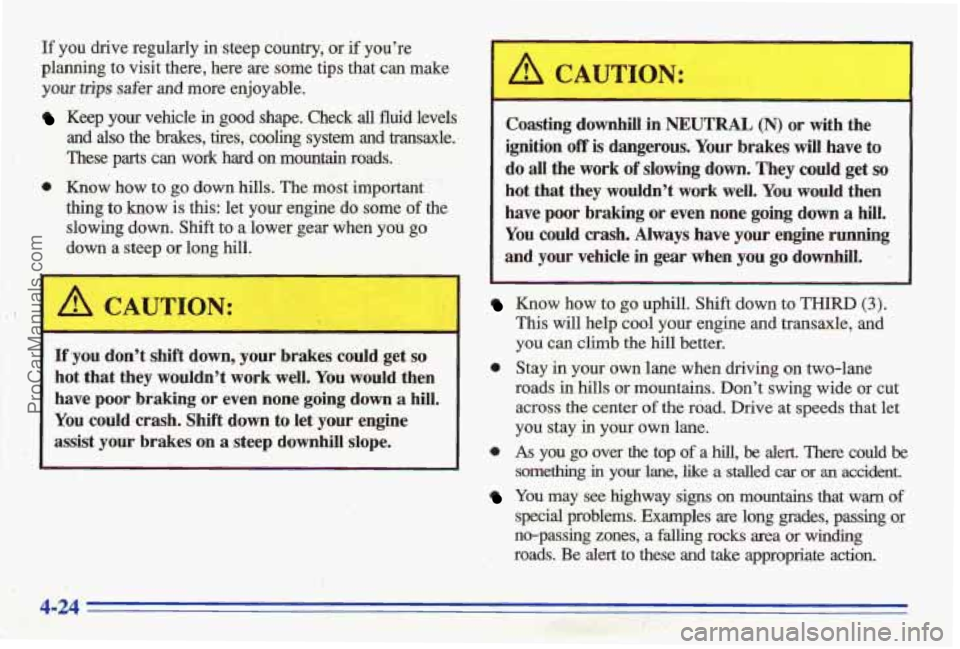
~f you drive regularly in steep country, or if you’re
planning to visit there, here
are some tips that can make
your trips safer and more enjoyable.
Keep you vehicle in good shape. Check all fluid levels
and also the brakes, tires, cooling system and transaxle.
These parts
can work hard on mountain roads.
0 Know how to go down hills. The most important
thing
to know is this: let your engine do some of the
slowing
down. Shift to a lower gear when you go
down a steep or long hill.
If ‘you don’t shift down, your brakes could get so
hot that they wouldn’f work well. You would then
have poor braking
or even none going down a hill.
You could crash. Shift down to let your engine
assist your brakes on
a steep downhill slope. Coasting
downhill in NEUTRAL (N) or with
the
ignition
off is dangerous. Your brakes will have to
do all the work of slowing down. They could get so
hot that they wouldn’t work well. You would then
have
pm braking or even none going down a hill.
1 You could crash. Always have your engine running
~ and your vehicle in gear when you go downhill.
Know how to go uphill. Shift down to THIRD (3).
This will help cool your engine and transaxle, and
you can climb the
hill better.
roads in
hills or mountains. Don’t swing wide or cut
across
the center of the road. Drive at speeds that let
you stay in your own lane.
0 Stay in your own he when driving on two-lane
0 As you go over the top of a hill, be dert. There could be
something in your lane, like a stalled car or an accident.
You may see highway signs on mountains that warn of
specid ‘problems. Examples are long grades, passing or
: I’ no-passing zones, a falling rwkx area or winding
,:\. .. roads. Be alert to these and take appropriate action.
ProCarManuals.com
Page 196 of 387
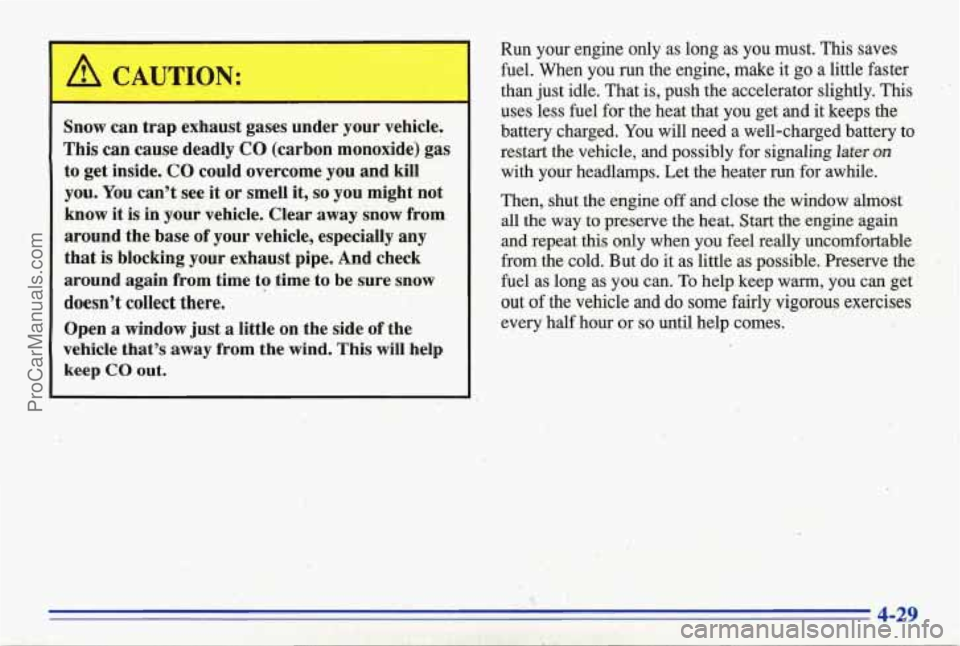
_I .
-- 1. <. i - .
A CAUTION:
Snow can trap exhaust gases under your vehicle.
This can cause deadly CO (carbon monoxide)'gas
to get inside. CO could overcome you and kill
you. Youxan't see
it or smell it, so you might not
~QW it is in your vehicle. Clear away snow from
around the base of your vehicle, especially any
that is blocking your exhaust pipe. And check
around again from time to time to be sure snow
doesn't
collect there.
Open
a window just a little on the side of the
vehicle
that's away from the wind. This will help
keep CO out.
Run your engine only as long as you must. This saves
fuel. When you run the engine, make it
go a little faster
than just idle. That is, push the accelerator slightly.
This
uses less fuel for the heat that you get and it keeps the
battery charged. You will need a well-charged battery to
restart the vehicle, and possibly for signaling
later OIZ
with your headlamps. Let the heater run for awhile.
Then, shut the engine
off and close the window almost
all the way to preserve the heat. Start the engine again
and repeat
this only when you feel really uncomfortable
from the cold. But do it as little as possible. Preserve the
fuel as long as you can.
To help keep warm, you can get
out of the vehicle and do some fairly vigorous exercises
every half hour or so until help comes.
4-29
a. . ProCarManuals.com
Page 204 of 387
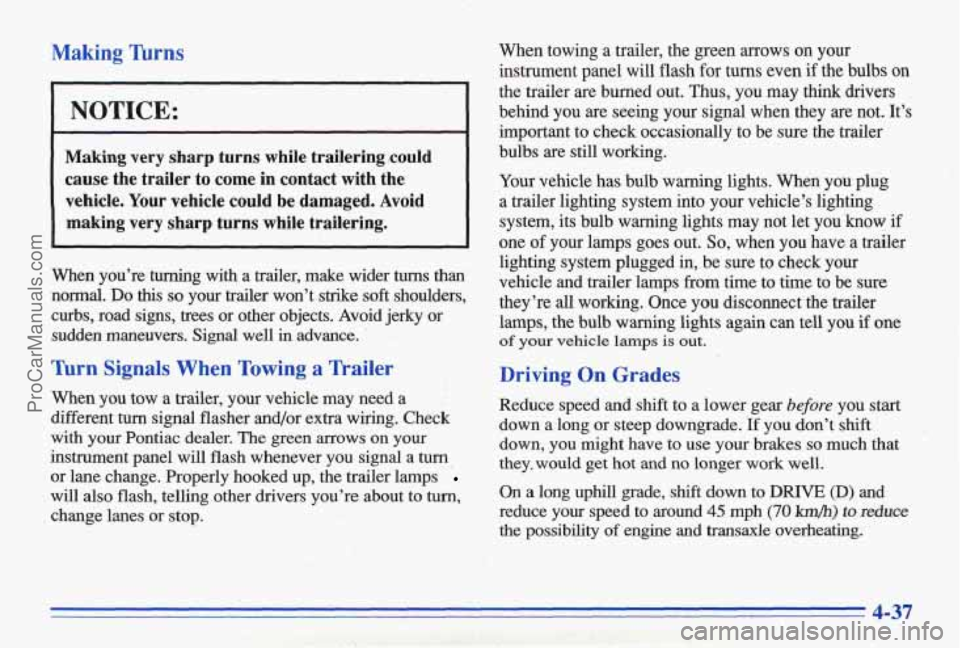
Making Turns
NOTICE:
Making very sharp turns while trailering could
cause the trailer to come in contact with the
vehicle. Your vehicle could be damaged. Avoid
making very sharp turns while trailering.
When you’re turning with a trailer, make wider turns than
normal. Do this so your trailer won’t strike soft shoulders,
curbs, road signs, trees or other objects. Avoid jerky
or
sudden maneuvers. Signal well in advance. ‘
. Turn ,Signals When Towing a Trailer’
When you tow a trailer, your vehicle may need a
different
turn signal flasher and/or extra wiring. Check
with your Pontiac dealer. The green
arrows on your
instrument panel will flash whenever you signal a turn
or lane change. Properly hooked up,’ the trailer lamps
will also flash, telling other drivers you’re about to turn,
change lanes or stop. When towing a trailer, the green arrows
on your
instrument panel will flash for turns
even if the bulbs on
the trailer are burned out.
Thus, you may think drivers
behind you are seeing your signal when they are not. It’s
important to check occasionally to be sure the trailer
bulbs are still working.
Your vehicle has bulb warning lights. When you’plug
a trailer lighting system into your vehicle’s lighting
system, its bulb warning lights may not let you
know if
one of your lamps goes out. So, when you have a trailer
lighting system plugged in, be sure to check your
vehicle and trailer lamps
from time to time to be sure
they’re
all working. Once you disconnect the trailer
lamps, the bulb warning lights again can tell you
if one
of ypur vehicle lamps is out.
Driving On Grades
Reduce speed and shift to a lower gear before you start
down a long or steep downgrade.
If you don’t shift
down, you might have to use your brakes so much that
they. would get hot
and no longer work well.
On a long uphill grade, shift down to Dm (D) and
reduce your speed to around
45 mph (70 km/h) to reduce
the possibility of engine and transaxle overheating.
4-37
ProCarManuals.com
Page 205 of 387
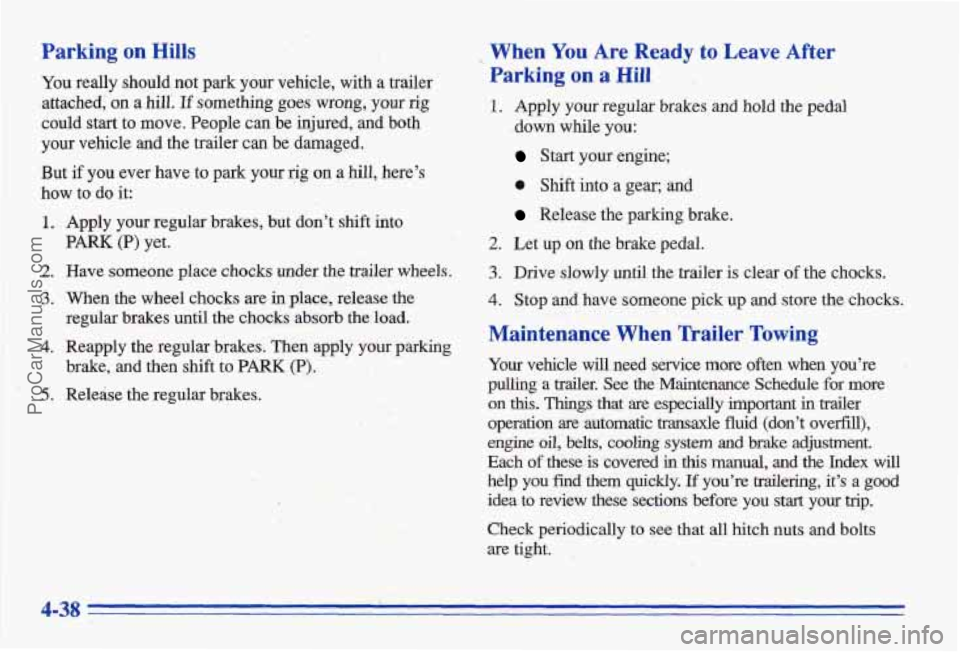
Parking on Hills
You really should not park your vehicle, with a trailer
attached,
on a hill. If something goes wrong, your rig
could start to move. People can be injured, and both
your vehicle and the trailer can be damaged.
But
if you ever have to park your rig on a hill, here’s
how to do it:
1. Apply your regular brakes, but don’t shift into
2. Have someone place chocks under the trailer wheels.
3. When the wheel chocks are in place, release the
regular brakes
mil the chocks absorb the load.
4. Reapply the regular brakes. Then apply your pa;rking
brake, and then shift to PdRK (P).
PARK (P) yet.
’ 5. Release the regular brakes.
~ When You Are Ready to Leave After
Parking on a Hill
1. Apply your regular brakes and hold the pedal
.down while
you:
Start your engine;
e Shift into a gear; and
Release the parking brake.
2. Let up on the brake pedal.
3. Drive slowly until the trailer is clear of the chocks.
4. Stop and have someone pick up and store the chocks.
Maintenance When Trailer Towing
Your vehicle will & service more often when you’re
pmg a trde~ See the Mainte~nance Schedule for more
on this. Things that are especially important in trailer
operation are .automatic
trande fluid (don’t overfill),
engine
oil, belts, cooling system and brake adjustment.
Each
of these is-covered in this manual, and the Index will
help you kd them quickly. If you’re tradering, it’s a good
idea to review these sections before you start your trip.
Check periodically to see that all hitch nuts and bolts
are tight.
4-38
ProCarManuals.com
Page 208 of 387
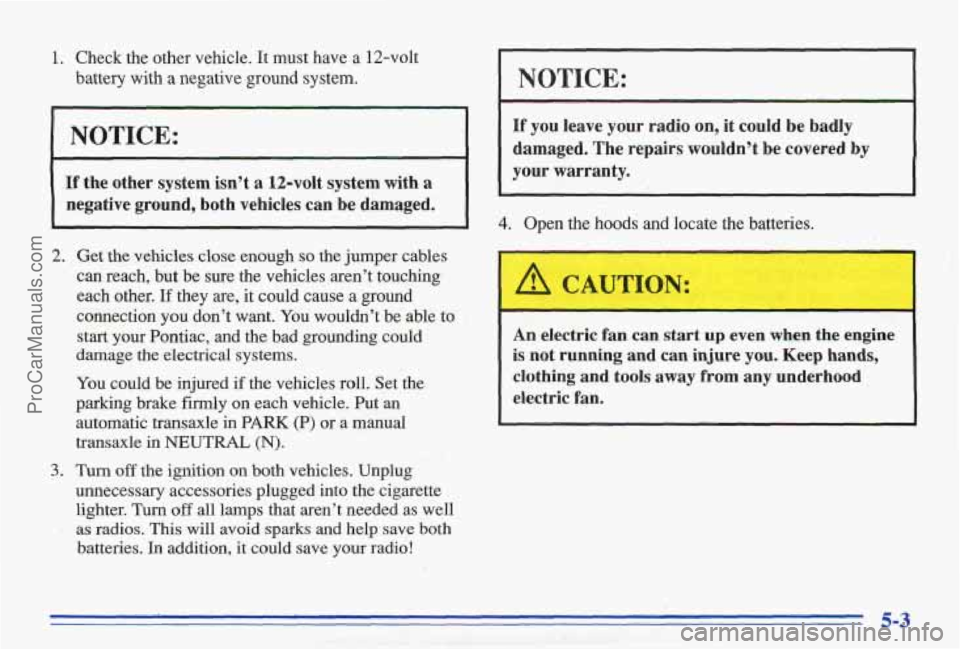
1. Check the other vehicle. It must have a 12-volt
battery with
a negative ground system.
NOTICE:
If the other system isn’t a 12-volt system with a
negative ground, both vehicles can be damaged.
2. Get the vehicles close enough so the jumper cables
can reach, but be sure the vehicles aren’t touching-
each other.
If they are, it could cause a ground
connection you don’t want. You wouldn’t be able
to
start your Pontiac, and the bad grounding could
damage the electrical systems.
You could be injured
if the vehicles roll. Set the
parking brake firmly on each vehicle. Put an
automatic transaxle in PARK (P) or a manual
transaxle
in NEUTRAL (N).
3. Turn off the ignition on both vehicles. Unplug
unnecessary accessories plugged into the cigarette
lighter. Turn
off all lamps that aren’t needed as well
I as radios. This will avoid sparks and help save both
batteries. In addition, it could save your radio!
NOTICE:
If you leave your radio on, it could be badly
damaged.
The repairs wouldn’t be covered by
your warranty.
4. Open the hoods and locate the batteries.
An electric fan can start ~ even wl 3 the engine
is not running and can injure you. Keep hands,
clothing and tools away
from any underhood
electric fan.
5-3
ProCarManuals.com
Page 209 of 387
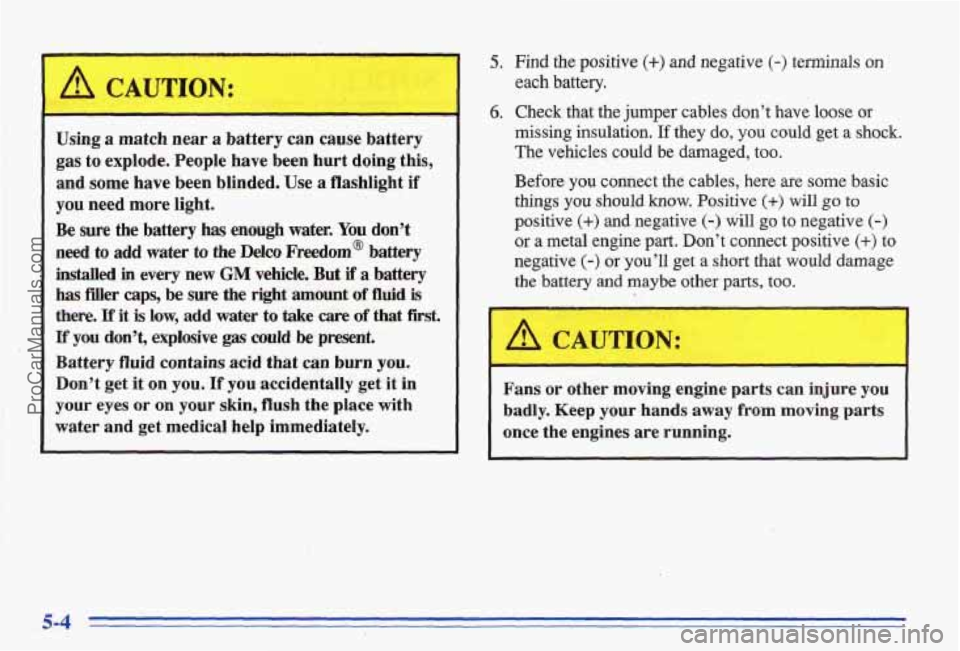
Using a match near a battery can cause battery
gas to exp1ode:People have been hurt doing this,
and some have been blinded. Use a flashlight
if
you need more light.
Be
sure the battery has enough water. You don’t
need to
add water to the Deko Freedom@ battery
installed
in every new GM vehicle, But if a battery
has filler caps, be sure the right mount of fluid is
there. If it is low, add water to take care of that first.
If you don’t, explosive gas could be present.
Battery fluid contains acid that can burn
you,
Don’t get it on you. If you accidentally get it in
your eyes
or on your skin, flush the place with
water and get medical help immediately.
5. Find the positive (+) and negative (-) terminals on
6. Check that the jumper cables don’t have loose or
each
battery.
missing insulation. If they do, you
could get a shock.
The vehicles could be damaged, too.
Before
you connect the cables, here are some basic
things you should know. Positive (+) will go to
positive (+) and negative (-) will go to negative (-)
or a metal engine part. Don’t connect positive (+)’ to
negative (-) or you’ll get a short that would damage
the battery and maybe other parts, too.
A CAUTION: I .
m Fans or other moving engme parts can injure yon
badly. Keep your hands away from moving parts
once the engines are running.
5-4
ProCarManuals.com
Page 223 of 387
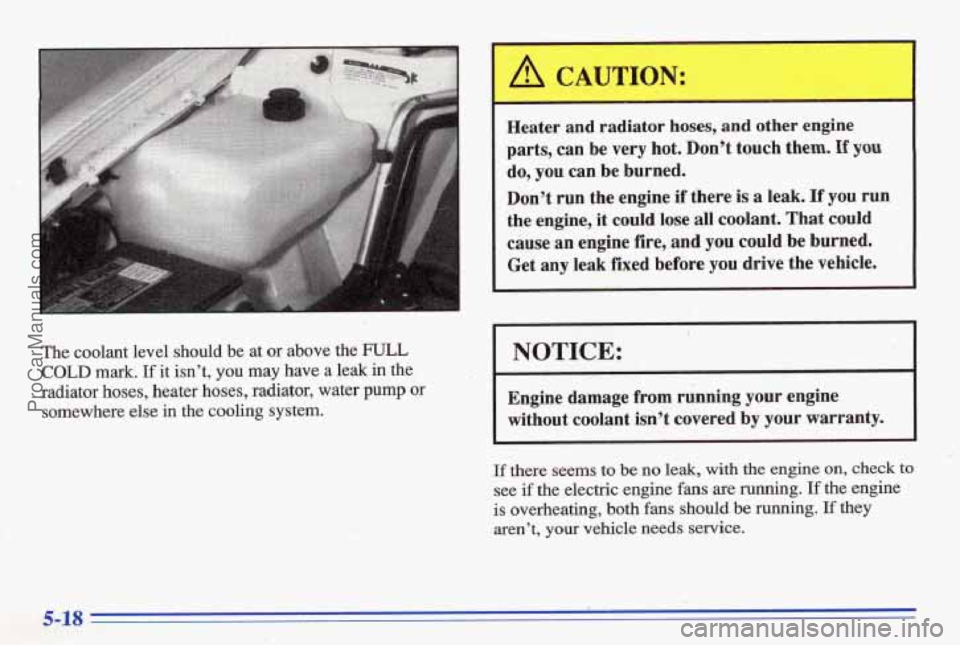
,
‘The coolant level should be at or above the FULL
% COLD mark. If it isn’t, you may have a leak in the
. radiator hoses, heater hoses, radiator, water pump or
somewhere else in the cooling system.
A CAWTION:
Heater and radiator hoses, and other engine
parts, can be
very hot. Don’t touch them. If you
do, you can be burned.
Don’t mn the engine
if there is a leak. If you run
’ the engine, it could lose all coolant. That could
cause an engine
fire, and you could be burned.
Get any leak fixed before you drive the vehicle.
I NOTICE:
I
Engine damage from running your engine
without coolant isn’t covered by your warranty.
I
If there seems to be no leak, with the engine on, check to
see if the electric engine fans are running. If the engine
is overheating, both fans should be running. If they
aren’t, your vehicle needs service.
ProCarManuals.com
Page 248 of 387

If you’re using fuel rated at the recommended octane or
higher and you stiil hear heavy knocking, your engine
needs service. But don’t worry
if you hear a little
pinging noise when you’re accelerating or driving up
a
hill. That’s normal, and you don’t have to buy a higher \
octane fuel to get rid of pinging. It’s the heavy, constant
knock that means you have a problem.
If your vehicle is certified to meet California Emission
Standards (indicated on the underhood tune-up ’label),
it is designed to operate on fuels that meet California
specifications.
If such fuels are not available in states
adopting California emissions standards, your vehicle
will operate satisfactorily on fuels meeting federal
specifications, but emission control system performance
may be eected. The malfunction indicator lamp on
your instrument panel may turn on and/or-your vehicle may fail a smog-check test.
If this occurs, return to your
authorized Pontiac dealer for diagnosis to determine the
cause of failure.
In the event it is determined that the
cause
of the condition is the type of fuels used, repairs
may not be covered by your warranty.
In Canada, some gasolines contain an octane-enhancing
additive called MMT.
If you use such fuels, your
, emission control system performance may deteriorate
and the malfunction indicator lamp on your instrument
panel may turn on.
If this happens, return to your
authorized Pontiac dealer for service.
To provide cleaner air, all gasolines are now required to
contain additives that will help prevent deposits from
forming in your engine and fuel system, allowing your
emission control system to function properly. Therefore,
you should not have to add anything
to the fuel. In
addition, gasolines containing oxygenates, such as
ethers and ethanol, and reformulated gasolines may
be available in your area to help clean the air. General
Motors recommends that you use these gasolines
if
they mcomply with the specifications described earlier.
NOTICE:
Your vehicle was not designed for fuel that
contains methanol. Don’t use it. It can corrode
metal parts in your fuel system and also damage
plastic and rubber parts. That damage
wouldn’t
be covered under your warranty.
ProCarManuals.com